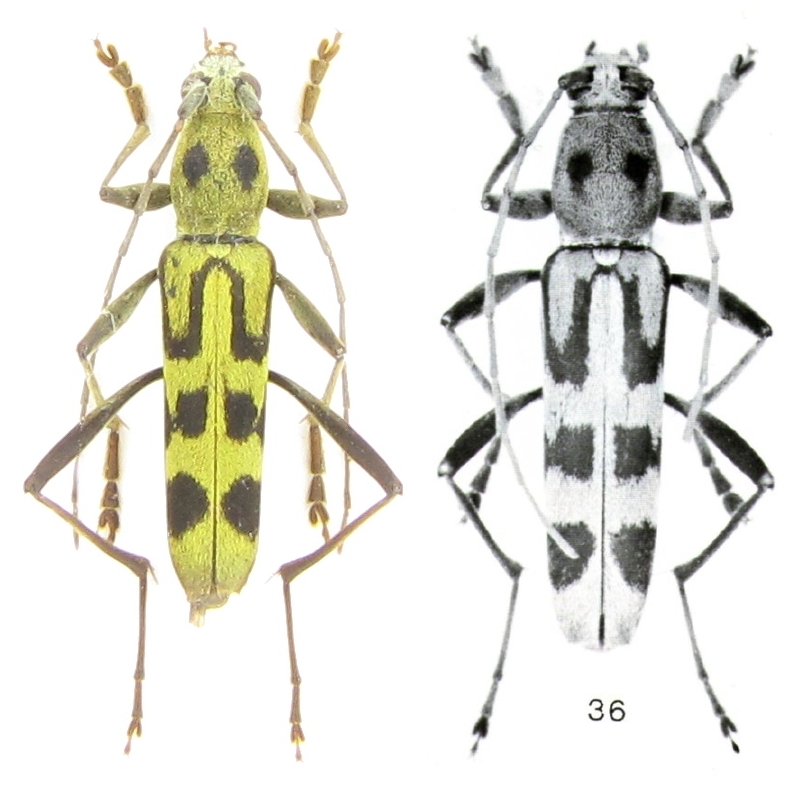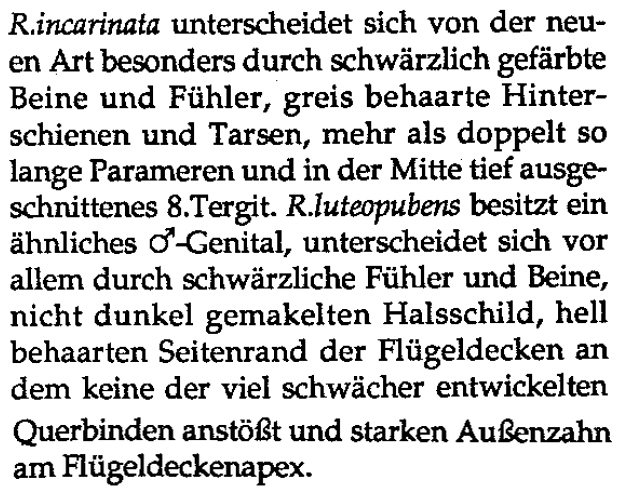| Author |
 Topic Topic  |
|
|
Vitali
Member Rosenbergia
   
Estonia
1001 Posts |
 Posted - 19/12/2013 : 17:09:20 Posted - 19/12/2013 : 17:09:20



|

237.59 KB
This beetle is very similar to Rhaphuma improba Holzschuh, 1992.
The holotype of the latter is on the right side of the photo. However, in the differential diagnosis, Holzschuh writes the following text:

194.78 KB
I could not find any picture of Rh. incarinata Pic, 1925. It is also a bit confusing to me, which of the species, Rh. incarinata or Rh. improba has blackish legs. According to the original description this should be Rh. improba, but the differential diagnosis tells seemingly the opposite. My German is not very good, though. |
Edited by - Xavier on 30/01/2016 20:31:28 |
|
|
Francesco
Forum Admin
    
Luxembourg
9511 Posts |
 Posted - 19/12/2013 : 17:26:28 Posted - 19/12/2013 : 17:26:28




|
Dear Vitali, one of the problems of Holzschuh's diagnoses is that they are written inverted: the old species is separated from the one just described, while it should be the contrary. Moreover, some necessary grammatical elements (personal adjectives) are absent, increasing the confusion.
In this case, R. incarinata [Pic] differs from R. improba for [its] blackish limbs, etc...
The sentence is clear reading the diagnosis of luteopubens ["nicht gemakelten Halsschlild"], which cannot belong to improba. |
 |
|
|
Vitali
Member Rosenbergia
   
Estonia
1001 Posts |
 Posted - 19/12/2013 : 17:34:31 Posted - 19/12/2013 : 17:34:31



|
Gressit indicates in the key to Rhaphuma species (in "Cerambycid-beetles of Laos") that Rhaphuma incarinata has 4 black spots in pronotum.
This may be a mistake. Holzschuh did not mention this for Rh. incarinata, while he wrote in the original description that Rh. improba has only two spots.
He would hardly overlooked such difference. |
 |
|
|
Vitali
Member Rosenbergia
   
Estonia
1001 Posts |
 Posted - 19/12/2013 : 17:49:59 Posted - 19/12/2013 : 17:49:59



|
quote:
Originally posted by Francesco
Dear Vitali, one of the problems of Holzschuh's diagnoses is that they are written inverted:
...
The sentence is clear reading the diagnosis of luteopubens ["nicht gemakelten Halsschlild"], which cannot belong to improba.
Dear Francesco. Thank you for explanation. I suspected something like this. |
 |
|
|
Xavier
Scientific Collaborator
    
France
12338 Posts |
 Posted - 19/12/2013 : 18:05:25 Posted - 19/12/2013 : 18:05:25



|
No mistake : R. incarinata has 4 spots on the pronotum. Here the original description of Pic 1925 :

This group is the hardest for me. Many "species" have the same or close pattern (R. luteopubens, R. quercus, R. phiale), and I think that there are also variations, (never seen in Holzschuh publications !!)... Are they all "good species" ?? |
Edited by - Xavier on 19/12/2013 18:06:13 |
 |
|
|
Xavier
Scientific Collaborator
    
France
12338 Posts |
 Posted - 19/12/2013 : 18:21:38 Posted - 19/12/2013 : 18:21:38



|
| Could you add the size of your specimen, Vitali ? |
 |
|
|
Vitali
Member Rosenbergia
   
Estonia
1001 Posts |
 Posted - 19/12/2013 : 19:20:50 Posted - 19/12/2013 : 19:20:50



|
The beetle is 13.5 mm, that is 2 mm smaller than the type specimen of Rh. improba.
You are right, Xavier, Rh. incarinata has 4 black spots in pronotum. It is strange that Holzschuh did not mention this. In such case I should be safe with Rh. improba, although the first band is thicker and with sharper angles than in the holotype.
This group of Rhaphuma contains a series of pretty similar species. The number of spots in pronotum, their size, the shape of the elytral bands are used to distinguish the species... if these characters are stable . .
|
 |
|
| |
 Topic Topic  |
|


